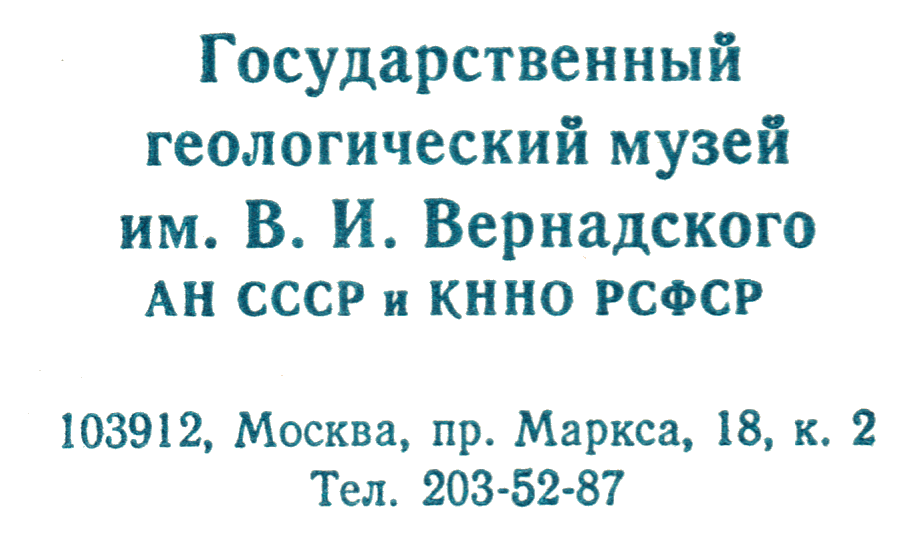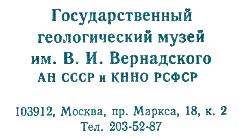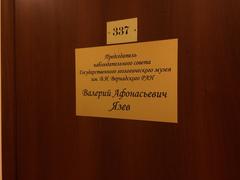
Vernadsky State Geological Museum Moscow: Comprehensive Visitor Guide
Date: 14/06/2025
Introduction
The Vernadsky State Geological Museum in Moscow is a distinguished scientific and cultural institution that showcases Russia’s geological heritage and the evolution of earth sciences. Established in the mid-18th century alongside Moscow Imperial University, the museum holds a significant place in the history of Russian science, education, and public outreach. Named after Vladimir I. Vernadsky, a pioneering Russian geochemist and mineralogist, the museum today offers visitors an immersive experience through its renowned mineral, rock, fossil, and meteorite collections. This guide provides a complete overview of the museum’s history, collections, visiting hours, ticketing, facilities, accessibility, and nearby attractions, ensuring you have all the information needed for a memorable visit.
Historical Overview
Foundations and Early Development (1755–1812)
The museum’s roots trace back to the founding of Moscow Imperial University in 1755, initiated by Mikhail V. Lomonosov and Ivan I. Shuvalov under Empress Elizaveta I Petrovna. Lomonosov, recognizing the importance of hands-on scientific education, advocated for a mineralogical collection to support teaching (Google Arts & Culture). The museum’s foundational collection began in 1759 with a donation of around 6,000 mineral and rock samples from the Demidov family, complemented by further gifts and endowments that established the Faculty of Natural History and Agriculture.
By 1791, the growing collection had evolved into the Museum of Natural History, occupying dedicated space in the university on Mokhovaya Street—its current location (Google Arts & Culture).
Turbulence and Recovery: The Napoleonic Era
During the 1812 French invasion of Moscow, much of the museum’s collection was lost. However, key specimens were saved through evacuation, and the collection was gradually restored thanks to further donations from patrons such as Nikolay N. Demidov (Google Arts & Culture). By 1814, the museum was reestablished, strengthening its role in Russian science.
Growth and Scientific Leadership in the 19th Century
Throughout the 19th century, the museum attracted prominent scientists, including Gotthelf Fischer von Waldheim, V.O. Kovalevsky, A.P. Pavlov, M.V. Pavlova, and Vladimir I. Vernadsky (Scientific Russia). The collection expanded through contributions from Russian nobility and scientific patrons, positioning the museum as a leading center for geological research and education.
The Soviet Era and Modernization
Named in honor of Vladimir I. Vernadsky in the 20th century, the museum became a hub for public science outreach, vocational training, and research in mineralogy and geochemistry. During the Soviet era, it received significant new collections and developed educational programs, exhibitions, and scientific conferences, further cementing its role as a public and scientific institution (Live the World).
Museum Collections
Mineralogical and Geological Holdings
The museum houses over 300,000 specimens, including minerals, rocks, ores, and meteorites from Russia and around the world (Scientific Russia). The systematic mineralogical collection is a highlight, featuring approximately 1,100 mineral species and notable gemstones such as the “Samarsky Diamond.”
- Mineralogy Hall: Exhibits gems and minerals from the Ural Mountains, Siberia, and global locales.
- Petrology and Geochemistry Hall: Showcases igneous, metamorphic, and sedimentary rocks, meteorites, and models explaining Earth’s structure.
- Paleontology Hall: Features fossilized flora and fauna, reconstructing ancient environments.
- Special Collections: Includes meteorites like “Pallas Iron,” rare mantle rocks from Antarctica, and scientific instruments from Vernadsky’s era (Google Arts & Culture).
Archival and Educational Resources
The museum maintains extensive archival materials—scientific articles, monographs, and manuscripts—that document the development of earth sciences in Russia. Digital resources and an Open Data Portal offer global access to catalogued collections (CEUR-WS).
Interactive and Thematic Exhibits
The museum regularly presents temporary exhibitions on themes such as meteorites, gemstones, and regional geology. Interactive displays, augmented reality, and educational workshops make the experience engaging for visitors of all ages.
Architectural and Institutional Significance
The museum occupies a historic early 20th-century building on Mokhovaya Street, designed by architect R.I. Klein. Its central location, directly opposite the Kremlin and Manezhnaya Square, highlights its status as a landmark in Moscow’s scientific and cultural landscape (Google Arts & Culture). As part of the Russian Academy of Sciences, the museum collaborates on international research and educational initiatives.
Visitor Information
Location and Accessibility
- Address: 11 Mokhovaya St., Moscow, Russia, 125009
- Metro Access: Okhotny Ryad (Line 1), Biblioteka Imeni Lenina (Line 1), Arbatskaya (Line 3)
- Public Transport: Bus and trolleybus stops at Manege Square or Mokhovaya Street
- Taxi/Ride-share: Drop-off zones near the entrance (Vernadsky Museum Official Site)
Opening Hours (as of June 2025)
- Tuesday to Sunday: 11:00 AM – 6:00 PM
- Closed: Mondays and select public holidays
- Last admission: 30 minutes before closing
Ticket Information
- Adults: 400 RUB
- Students, children, seniors: 100–200 RUB
- Children under 7: Free
- Group tours and educational programs: Book in advance; discounts available (Vernadsky Museum Tickets)
Facilities and Amenities
- Cloakroom: Free, near the entrance
- Restrooms: Accessible, ground floor
- Gift Shop: Geological souvenirs, minerals, books (museum shop)
- Café: Light snacks and refreshments
- Wi-Fi: Free throughout the museum
- Accessibility: Ramps, elevators to main exhibition floors; some historic areas have limited access (Moscow Museums Accessibility)
Exhibitions and Activities
Permanent Halls
- Mineralogy: Over 50,000 specimens, including gems and meteorites
- Petrology & Geochemistry: Rocks, volcanic models, and interactive displays
- Paleontology: Fossils and reconstructions of prehistoric life
- History of Geology: Tracing the development of geological sciences in Russia
Temporary Exhibitions and Events
The museum hosts rotating exhibitions on topics such as volcanology, gemstones, and mining history. Annual events like “Night of Museums” and “Science Festival” feature extended hours, lectures, and family activities (event calendar).
Guided Tours and Educational Programs
- Languages: Russian and English (advance booking for English tours)
- Duration: 60–90 minutes
- Specialized tours: Focus on mineralogy, paleontology, or Russian geology (guided tours)
- Workshops: Interactive activities for children and school groups (Family Activities at Vernadsky Museum)
Practical Tips for Visitors
- Crowds: Weekday mornings and late afternoons are quieter; weekends and holidays are busier.
- Photography: Non-flash photography allowed in most areas; no tripods or commercial shooting without permission.
- Language Support: Bilingual signage; audio guides and brochures in English and other languages.
- Duration: Allocate 2–3 hours for a thorough visit.
- Dress: Comfortable shoes recommended; some historic floors may be uneven.
- Accessibility: Partial—some historic areas may have limited access.
- Family-Friendly: Stroller access, baby-changing facilities, and children’s activity zones.
Nearby Attractions
The museum’s central location makes it easy to pair your visit with other Moscow highlights:
- The Kremlin and Red Square
- Manezhnaya Square
- Alexander Garden
- State Historical Museum
- Pushkin State Museum of Fine Arts
(Moscow Museum Guide)
Frequently Asked Questions (FAQ)
Q: What are the museum’s opening hours?
A: Tuesday to Sunday, 11:00 AM–6:00 PM; closed on Mondays and select holidays.
Q: How much are tickets?
A: Adults: 400 RUB; discounts for students, children, seniors; children under 7 free.
Q: Is the museum accessible for people with disabilities?
A: Yes, ramps and elevators are available. Some historic areas may be less accessible.
Q: Are guided tours available in English?
A: Yes, by prior arrangement.
Q: Can I take photos inside?
A: Non-flash, personal photography is allowed in most areas.
Q: Where is the museum located?
A: 11 Mokhovaya Street, Moscow, near the Kremlin and Red Square.
Conclusion
The Vernadsky State Geological Museum is a premier destination for anyone interested in geology, Russian scientific heritage, or the natural wonders of our planet. Its vast collections, educational programs, and accessible facilities make it suitable for visitors of all ages and backgrounds. Plan your visit using the latest information on opening hours, ticketing, exhibitions, and nearby attractions for an enriching experience in the heart of Moscow.
Useful References and Further Information
- Vernadsky State Geological Museum Exhibit, Google Arts & Culture
- Scientific Russia – Vernadsky State Geological Museum
- Official Museum Website
- Visitor Information and Tickets
- Guided Tours
- Museum Events
- Accessibility Details
- Moscow Museum Guide
- Live the World – Vernadsky Museum
- CEUR-WS: Museum Open Data
- TripAdvisor Reviews
For the latest updates, download the Audiala app for interactive tours and follow the museum on social media. Start your geological adventure today at the Vernadsky State Geological Museum!






















































































































































































































































































